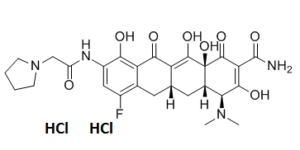Eravacycline 2HCl
This product is for research use only, not for human use. We do not sell to patients.

For small sizes, please check our retail website as below: www.invivochem.com
| Size | Price | Stock |
|---|---|---|
| 500mg | $989 | To Be Confirmed |
| 1g | $1550 | To Be Confirmed |
| 5g | $3925 | To Be Confirmed |
Cat #: V3876 CAS #: 1334714-66-7 Purity ≥ 98%
Description: Eravacycline 2HCl (formerly TP-434 or 7-fluoro-9-pyrrolidinoacetamido-6-demethyl-6-deoxytetracycline; trade name: Xerava), the dihydrochloride salt of eravacycline, is an approved antibiotic of the tetracycline class.
Top Publications Citing Invivochem Products
Publications Citing InvivoChem Products
Product Promise

- Physicochemical and Storage Information
- Protocol
- Related Biological Data
- Stock Solution Preparation
- Quality Control Documentation
| Molecular Weight (MW) | 631.48 |
|---|---|
| Molecular Formula | C27H33Cl2FN4O8 |
| CAS No. | 1334714-66-7 |
| Storage | -20℃ for 3 years in powder formrr |
| -80℃ for 2 years in solvent | |
| Solubility In Vitro | DMSO: >10 mMrr |
| Water: 50 mg/mLrr | |
| Ethanol: N/A | |
| SMILES Code | O=C(C1=C(O)[C@@H](N(C)C)[C@@](C[C@@]2([H])C(C(C3=C(O)C(NC(CN4CCCC4)=O)=CC(F)=C3C2)=O)=C5O)([H])[C@@]5(O)C1=O)N.[H]Cl.[H]Cl |
| Synonyms | TP434 2HCl; TP-434 2HCl; TP 434; TP434; Eravacycline 2HCl; Eravacycline dihydrochloride. |
| Protocol | In Vitro | Eravacycline is potent antibiotic against A. baumannii, including isolates that are resistant to sulbactam, imipenem/meropenem, levofloxacin, and amikacin/tobramycin. Eravacycline shows greater activity than the comparators of the tetracycline class, levofloxacin, amikacin, tobramycin, and colistin. The eravacycline MIC50/90 values are 0.5/1 mg/L[1]. Eravacycline shows inhibitory effects on six E. coli with MICs ranging from 0.125 to 0.25 mg/L[2]. Eravacycline dihydrochloride is a synthetic antibiotic, with inhibits bacterial protein synthesis through binding to the 30S ribosomal subunit. Eravacycline displays broad spectrum activity against gram-negative bacteria in the panel except P. aeruginosa, as well as excellent activity against major gram-positive pathogens, including methicillin-resistant S. aureus. Eravacycline also displays potent ribosomal inhibition[3]. Eravacycline shows potent broad-spectrum activity against 90% of the isolates (MIC90) in each panel at concentrations ranging from ≤0.008 to 2 μg/mL for all species panels except those of Pseudomonas aeruginosa and Burkholderia cenocepacia (MIC90 values of 32 μg/mL for both organisms). Eravacycline is active against multidrug-resistant bacteria, including those expressing extended-spectrum β-lactamases and mechanisms conferring resistance to other classes of antibiotics, including carbapenem resistance[4]. |
|---|---|---|
| In Vivo | Mice are treated with two-fold increasing doses (range 3.125 to 50 mg/kg) of eravacycline every 12 hours. The mean fAUC/MIC magnitude associated with net stasis and 1-log kill endpoint are 27.97±8.29 and 32.60±10.85, respectively[2]. Eravacycline is active in multiple murine models of infection against clinically important Gram-positive and Gram-negative pathogens. Eravacycline is efficacious in mouse septicemia models, demonstrating 50% protective dose values of ≤1 mg/kg of body weight once a day (q.d.) against Staphylococcus aureus, including tetracycline-resistant isolates of methicillin-resistant S. aureus (MRSA), and Streptococcus pyogenes. The PD50 values against Escherichia coli isolates are 1.2 to 4.4 mg/kg q.d[5]. |
These protocols are for reference only. InvivoChem does not
independently validate these methods.
| Solvent volume to be added | Mass (the weight of a compound) | |||
|---|---|---|---|---|
| Mother liquor concentration | 1mg | 5mg | 10mg | 20mg |
| 1mM | 1.5836 mL | 7.9179 mL | 15.8358 mL | 31.6716 mL |
| 5mM | 0.3167 mL | 1.5836 mL | 3.1672 mL | 6.3343 mL |
| 10mM | 0.1584 mL | 0.7918 mL | 1.5836 mL | 3.1672 mL |
| 20mM | 0.0792 mL | 0.3959 mL | 0.7918 mL | 1.5836 mL |
The molarity calculator equation
Mass(g) = Concentration(mol/L) × Volume(L) × Molecular Weight(g/mol)
Mass
=
Concentration
×
Volume
×
Molecular Weight*
The dilution calculator equation
Concentration(start)
×
Volume(start)
=
Concentration(final)
×
Volume(final)
This equation is commonly abbreviated as: C1 V1 = C2 V2
Concentration(start)
C1
×
Volume(start)
V1
=
Concentration(final)
C2
×
Volume(final)
V2
Step One: Enter information below
Dosage mg/kg
Average weight of animals g
Dosing volume per animal µL
Number of animals
Step Two: Enter the in vivo formulation
%DMSO
+
%
+
%Tween 80
+
%ddH2O
Calculation Results:
Working concentration:
mg/ml;
Method for preparing DMSO master liquid:
mg
drug pre-dissolved in
µL
DMSO(Master liquid concentration
mg/mL)
,Please contact us first if the concentration exceeds the DMSO solubility of the batch of drug.
Method for preparing in vivo formulation:
Take
µL
DMSO master liquid, next add
µL
PEG300, mix and clarify, next add
µL
Tween 80,mix and clarify, next add
µL
ddH2O,mix and clarify.
Note:
- (1) Please be sure that the solution is clear before the addition of next solvent. Dissolution methods like vortex, ultrasound or warming and heat may be used to aid dissolving.
- (2) Be sure to add the solvent(s) in order.




































